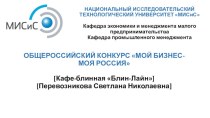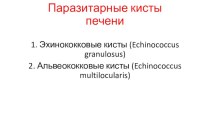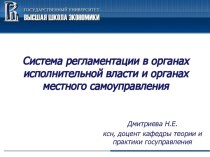- Главная
- Разное
- Бизнес и предпринимательство
- Образование
- Развлечения
- Государство
- Спорт
- Графика
- Культурология
- Еда и кулинария
- Лингвистика
- Религиоведение
- Черчение
- Физкультура
- ИЗО
- Психология
- Социология
- Английский язык
- Астрономия
- Алгебра
- Биология
- География
- Геометрия
- Детские презентации
- Информатика
- История
- Литература
- Маркетинг
- Математика
- Медицина
- Менеджмент
- Музыка
- МХК
- Немецкий язык
- ОБЖ
- Обществознание
- Окружающий мир
- Педагогика
- Русский язык
- Технология
- Физика
- Философия
- Химия
- Шаблоны, картинки для презентаций
- Экология
- Экономика
- Юриспруденция
Что такое findslide.org?
FindSlide.org - это сайт презентаций, докладов, шаблонов в формате PowerPoint.
Обратная связь
Email: Нажмите что бы посмотреть
Презентация на тему Test planning seminar
Содержание
- 2. AgendaPart 1:IntroductionSoftServe templateOverview of Major Sections. ExamplesPart 2:Test Planning Activities:Test ScopingTest Approach developmentEstimatingSchedulingExecution and Monitoring
- 3. IntroductionIntroduction – SoftServe Template – Major Sections Overview
- 4. Introduction: Basic TermsTesting Test PlanTest Planning Introduction –
- 5. Test Planning: 5 WsIntroduction – SoftServe Template – Major Sections Overview
- 6. Test Planning: MythsMyth #1 Test Plan is the
- 7. Standards Regulating Test PlanInstitute of Electrical and
- 8. Master Test Plan1. Introduction1.1. Document identifier1.2. Scope1.3.
- 9. SoftServe TemplateIntroduction – SoftServe Template – Major Sections Overview
- 10. SoftServe TemplateTest Plan 1 Introduction 1.1 Purpose 1.2 Overview 1.3 References 1.4 Definitions, Acronyms and
- 11. SoftServe TemplatesIntroduction – SoftServe Template – Major Sections OverviewBased on IEEE 829
- 12. Major Sections of a Test PlanIntroduction – SoftServe Template – Major Sections Overview
- 13. Major Parts: Static vs. DynamicIntroduction – SoftServe Template – Major Sections Overview
- 14. Major Sections: IntroductionIdentifierName which uniquely identifies the
- 15. Major Sections: Introduction1. Introduction1.1 PurposeThe purpose of
- 16. Major Sections: Test ItemsTest ItemsTest plan section
- 17. Test Items: Let’s Practice!Test Items The following components
- 18. Major Sections: FeaturesFeatures to be TestedList of
- 19. Major Sections: Quality AttributesIntroduction – SoftServe Template – Major Sections Overview
- 20. Features To Be Tested: Let’s Practice!Features to
- 21. Major Sections: Strategy/ ApproachTest Strategy/ApproachThe MOST important
- 22. Major Sections: Entry/Exit CriteriaEntry/Exit CriteriaEntry - conditions
- 23. Major Sections: Entry/Exit CriteriaEntry CriteriaTest Plan is
- 24. Major Sections: Suspension & ResumptionSuspension Criteria and
- 25. Major Sections: Suspension & Resumption Suspension Criteria
- 26. Major Sections: Pass/Fail CriteriaItem Pass/Fail CriteriaThese are
- 27. Major Sections: Pass/Fail CriteriaItem Pass/Fail CriteriaFunctional testing
- 28. Major Sections: DeliverablesTest DeliverablesSection describing the work
- 29. Major Sections: Tasks and EnvironmentTesting TasksSet of
- 30. Major Sections: Staff & ResponsibilitiesResponsibilitiesMapping of project
- 31. Major Sections: ScheduleScheduleCommonly this is a dynamic
- 32. Major Sections: RisksRisks and ContingenciesList of possible
- 33. Risk-Based Testing Risk-based testing is a highly
- 34. Major Sections: ApprovalsApprovalsList of project stakeholders with
- 35. Test Plan ExampleIntroduction – SoftServe Template – Major Sections Overview
- 36. Questions are Welcome!
- 37. Test Planning SeminarPart #2
- 38. AgendaPart 1:IntroductionSoftServe templateOverview of Major Sections. ExamplesPart
- 39. Test Planning Activities: Test ScopeScope – Approach– Estimate – Schedule – Execution &Monitoring
- 40. Test Planning as a ProcessScope – Approach– Estimate – Schedule – Execution &Monitoring
- 41. Introduction – SoftServe Template – Major Sections OverviewTest Scope=Test Items + Test Items’ Quality Characteristics
- 42. Test ScopeTest Item - an object that
- 43. ISO/IEC 9126. Quality Model FunctionalitySuitabilityAccuracyInteroperabilitySecurityFunctionality ComplianceReliabilityMaturityFault ToleranceRecoverabilityUsabilityUnderstandabilityLearnabilityOperabilityAttractivenessMaintainabilityAnalyzabilityChangeabilityStabilityTestabilityEfficiencyTime BehaviorResource UtilizationPortabilityAdaptabilityInstallabilityCo-ExistenceReplaceabilityScope – Approach– Estimate – Schedule – Execution &Monitoring
- 44. FURPS Quality Model FunctionalityFeature setCapabilities GeneralitySecurityUsabilityHuman factorsAestheticsConsistencyDocumentationReliabilityFrequency/severity of
- 45. Practical Guide to Test ScopingIdentify and write
- 46. Test Planning Activities: Test ApproachScope – Approach– Estimate – Schedule – Execution &Monitoring
- 47. Test Approach in 3 StepsTest Approach Implementation
- 48. Practical Guide to Test Approach Examination MethodDynamic
- 49. Test Levels. Need to Know While developing
- 50. Let’s Practice!Identify test itemsSelect applicable quality characteristics
- 51. Test Planning Activities: EstimatingScope – Approach– Estimate – Schedule – Execution &Monitoring
- 52. EstimatingEstimation is the calculated approximation of a
- 53. Practical Guide to Tests EstimatingWrite down all
- 54. Test Planning Activities: SchedulingScope – Approach– Estimate – Schedule – Execution &Monitoring
- 55. Scheduling Scheduling is the process of deciding
- 56. Practical Guide to SchedulingAs test scheduling always
- 57. Test Planning Activities: Execution & MonitoringScope – Approach– Estimate – Schedule – Execution &Monitoring
- 58. Test Approach Execution Test Execution - a
- 59. Monitoring in MetricsTest Process MetricsTest Designnumber of
- 60. Monitoring in MetricsTest Product Metrics - Defects
- 61. Monitoring in Metrics
- 62. ReportingStatus reporting/Test Summary ReportAgreed FormatDocument, e-mail, status
- 63. Questions are Welcome!
- 64. Скачать презентацию
- 65. Похожие презентации

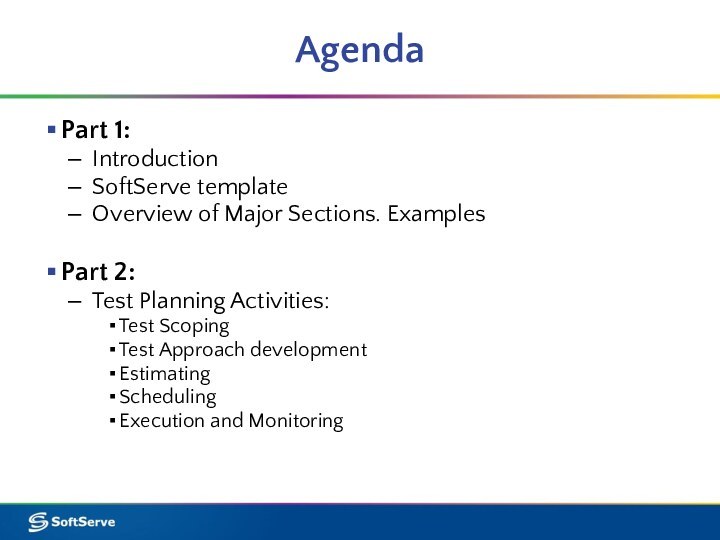
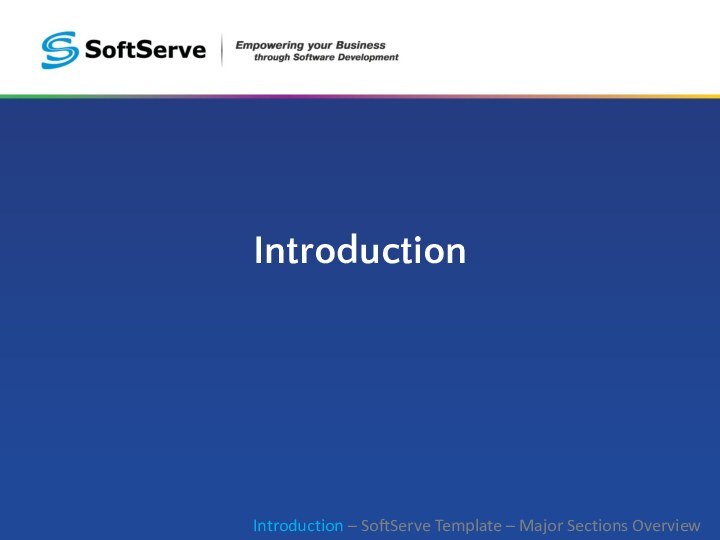

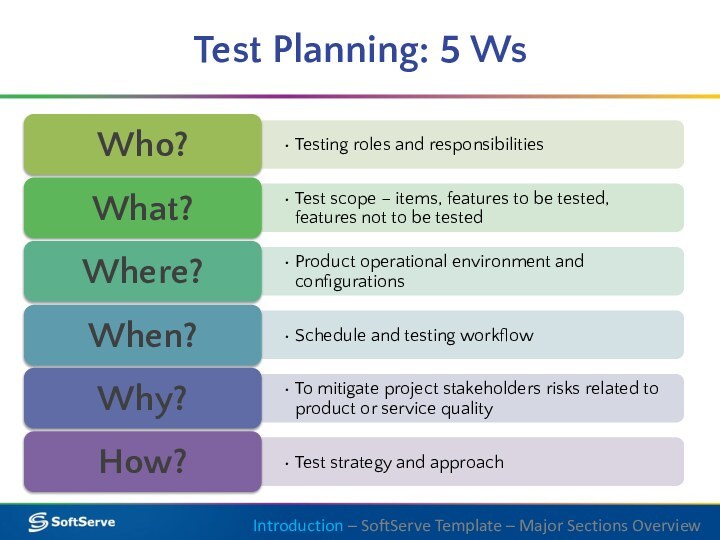
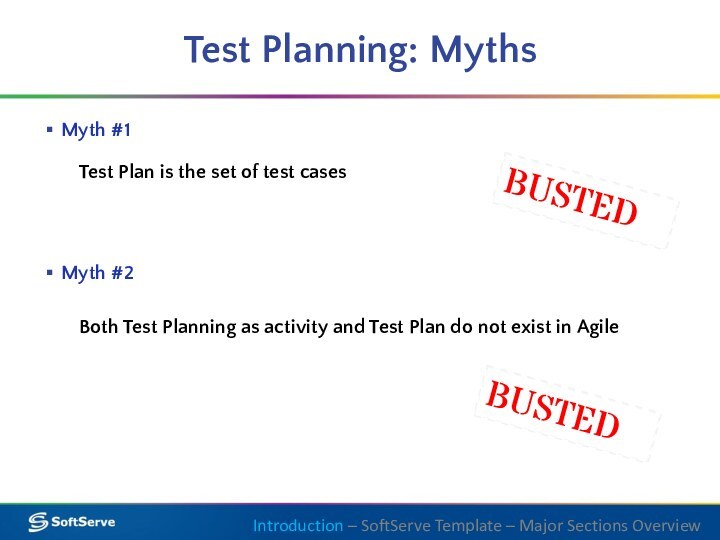

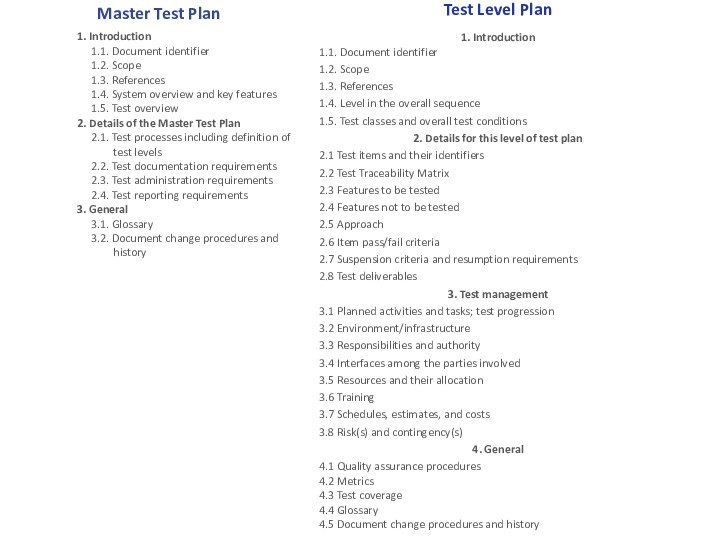
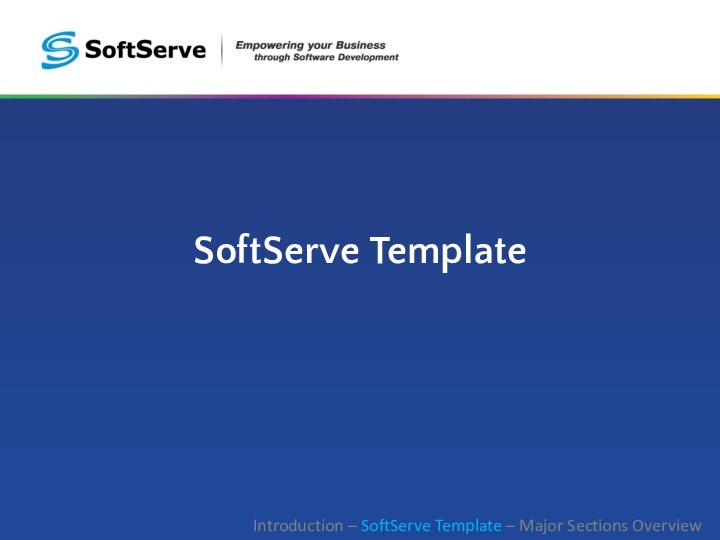
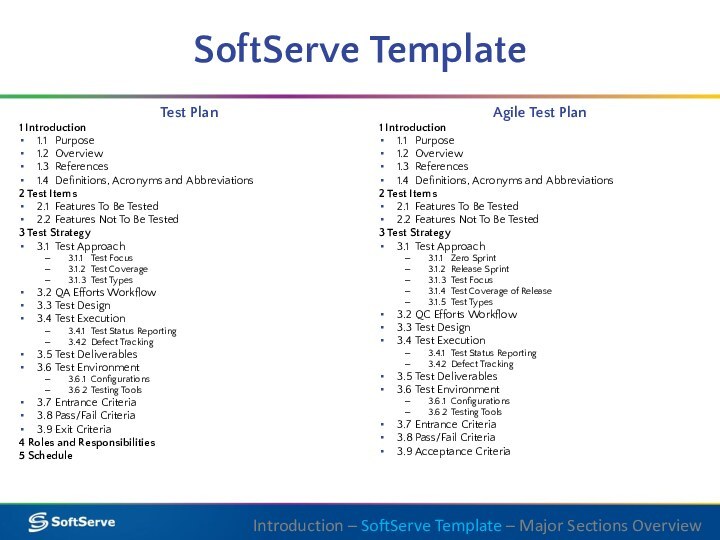
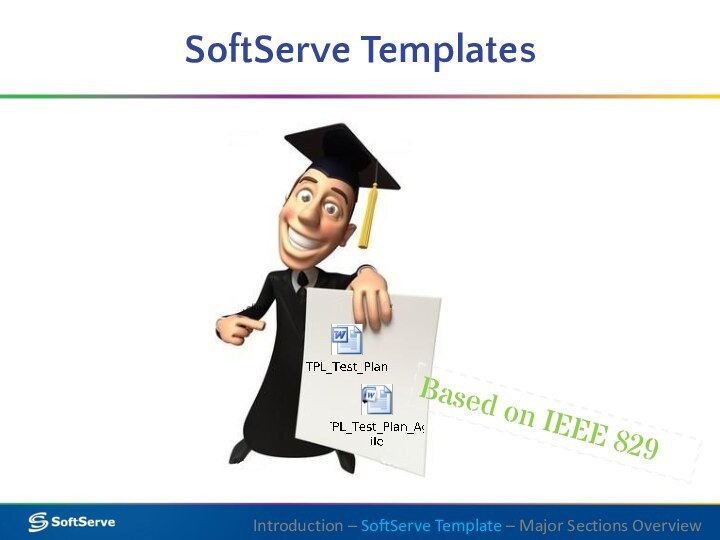

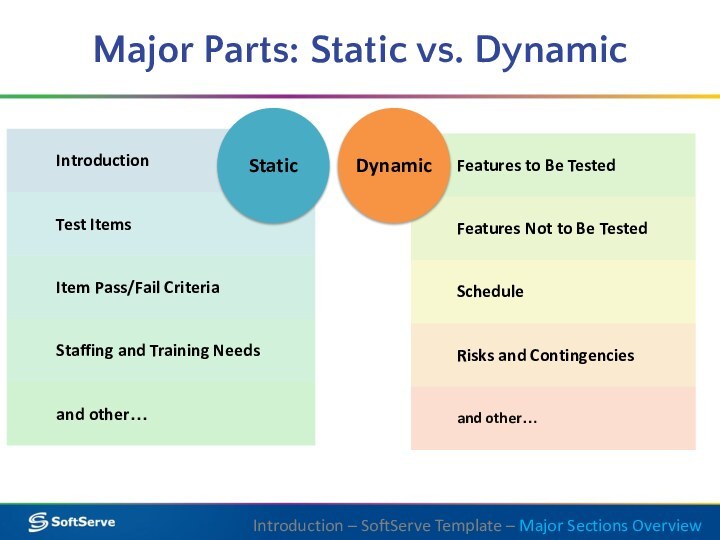
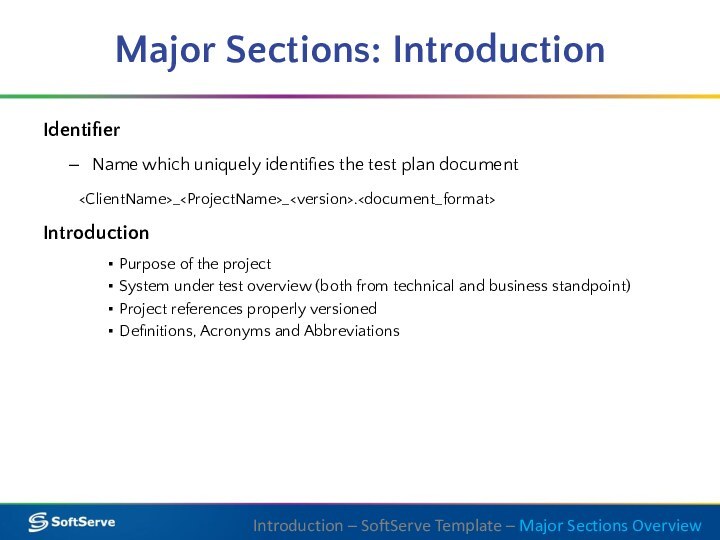

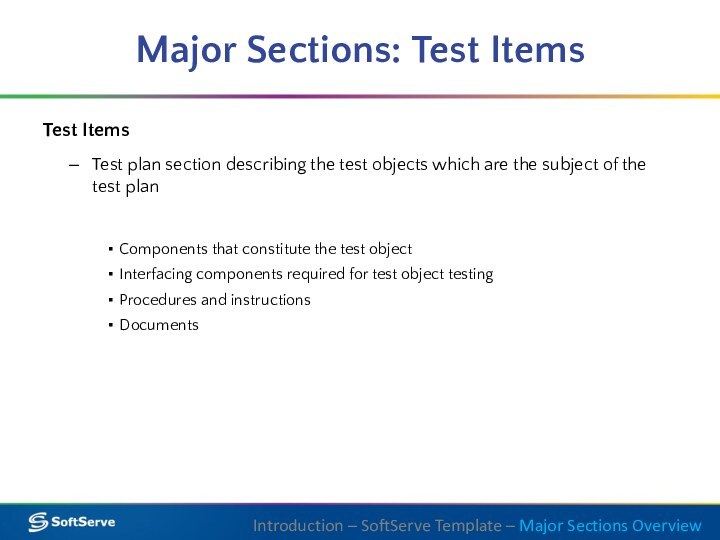
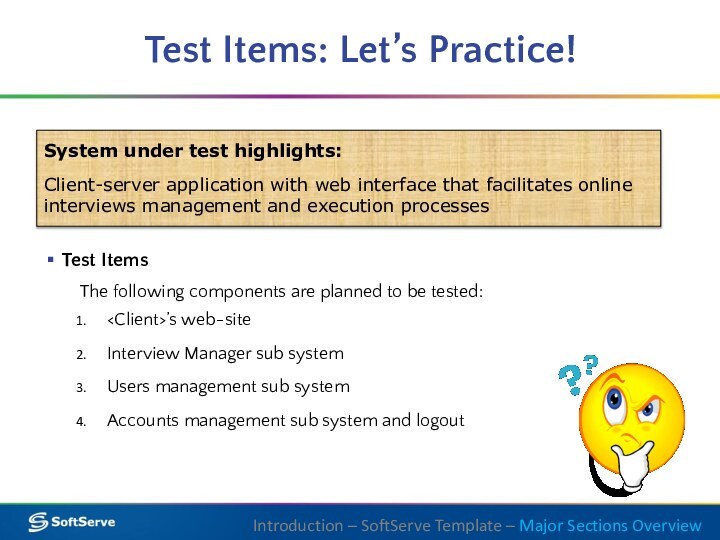


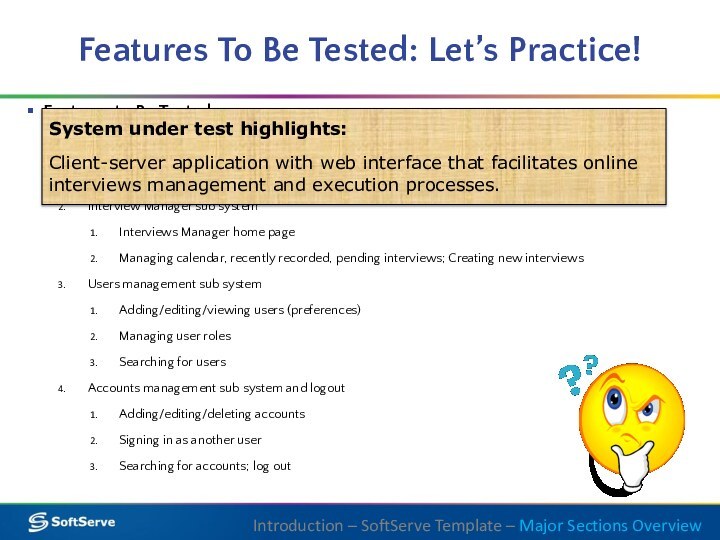
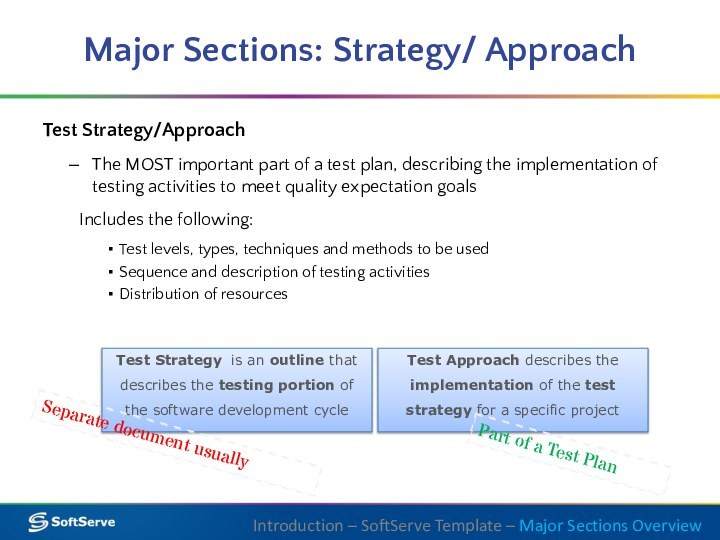

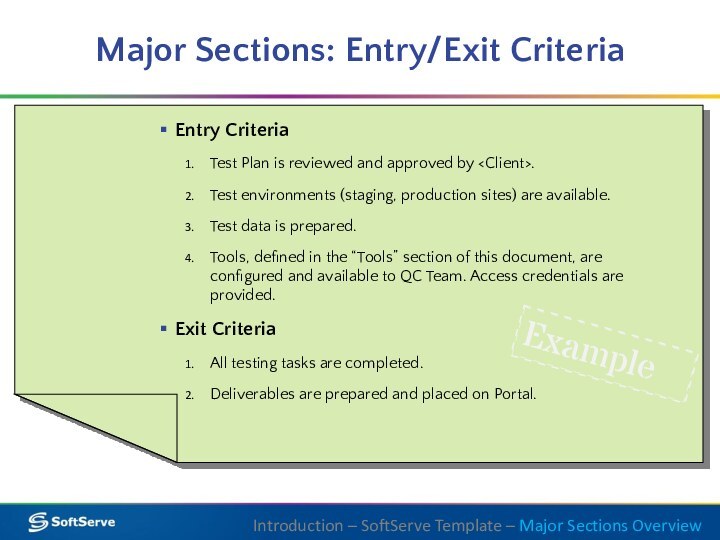


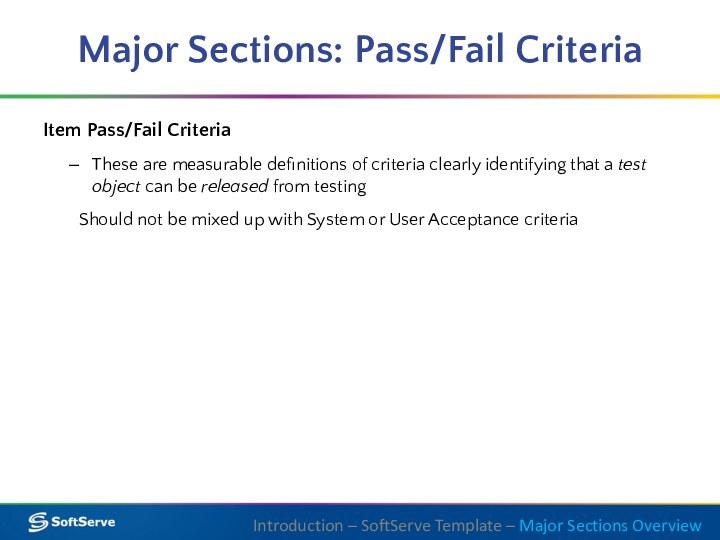
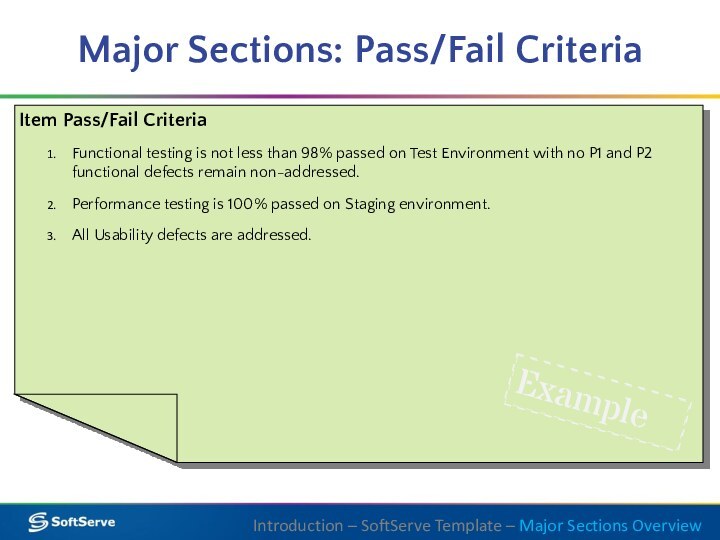
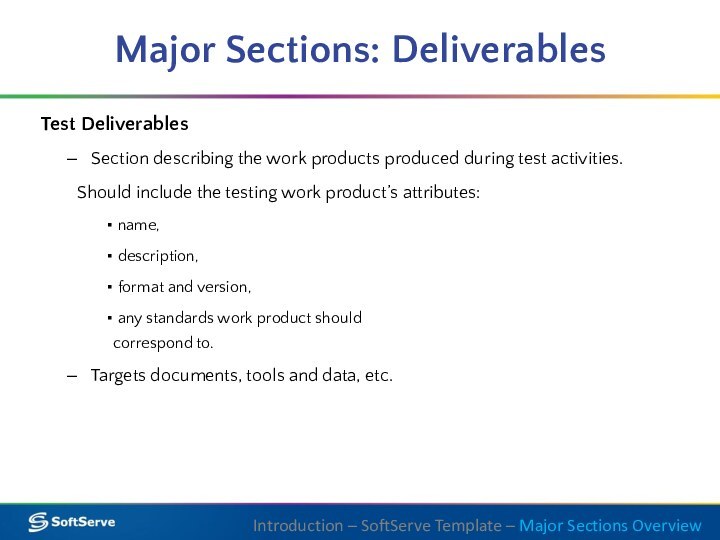
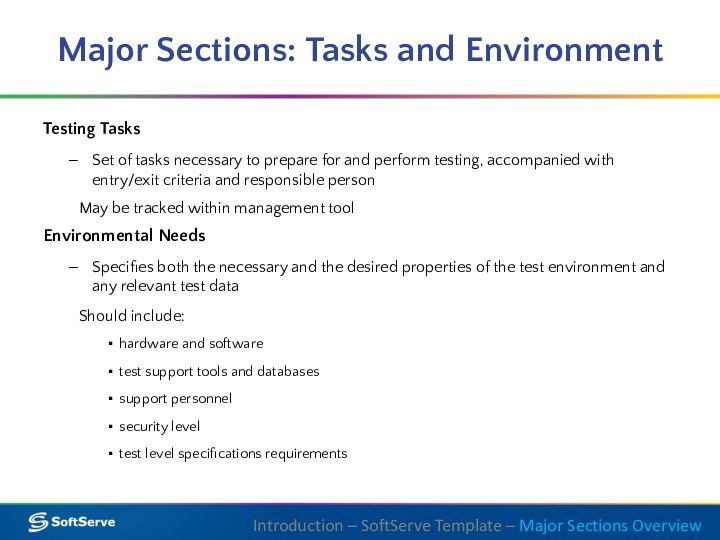
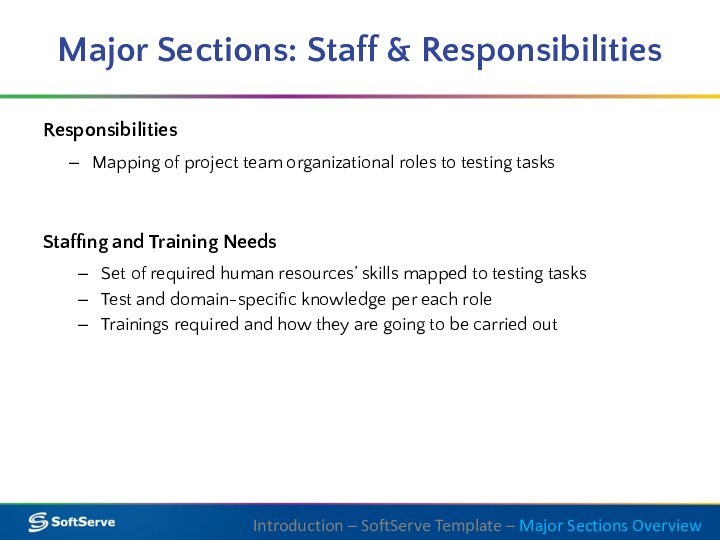
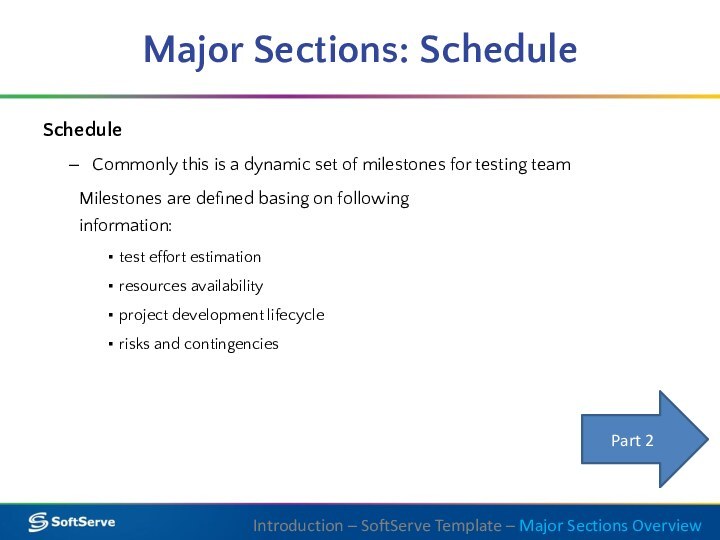

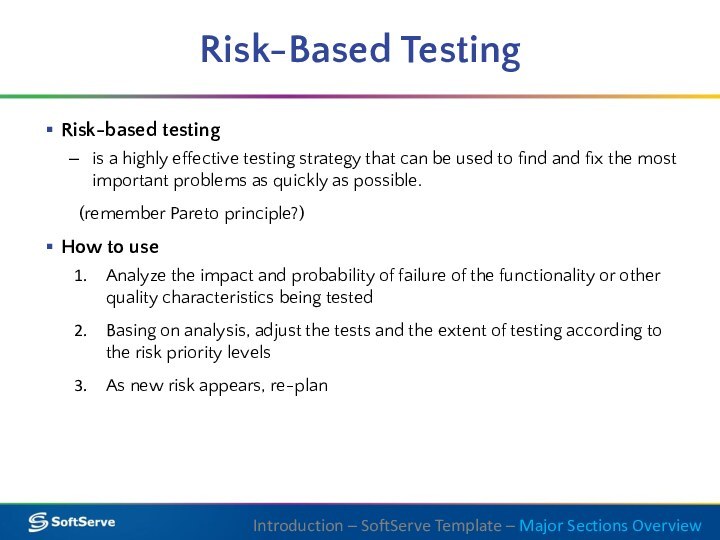

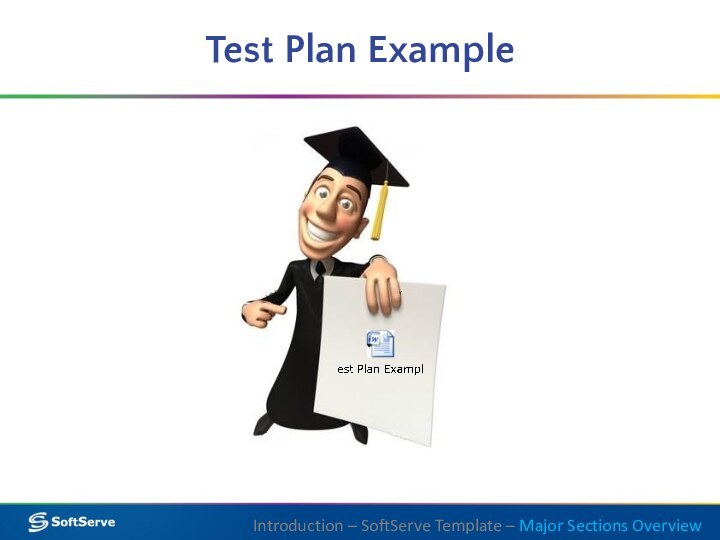




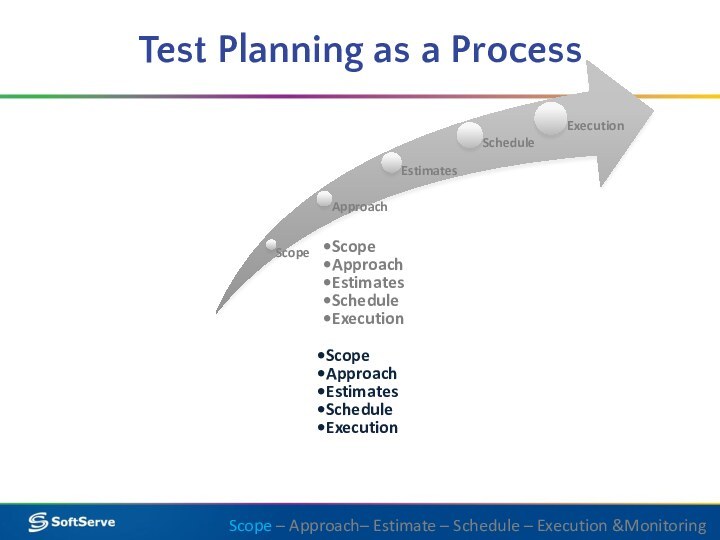
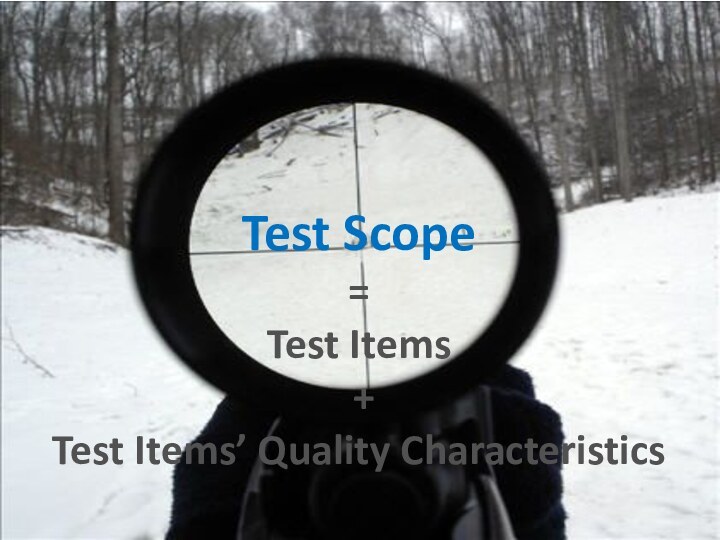
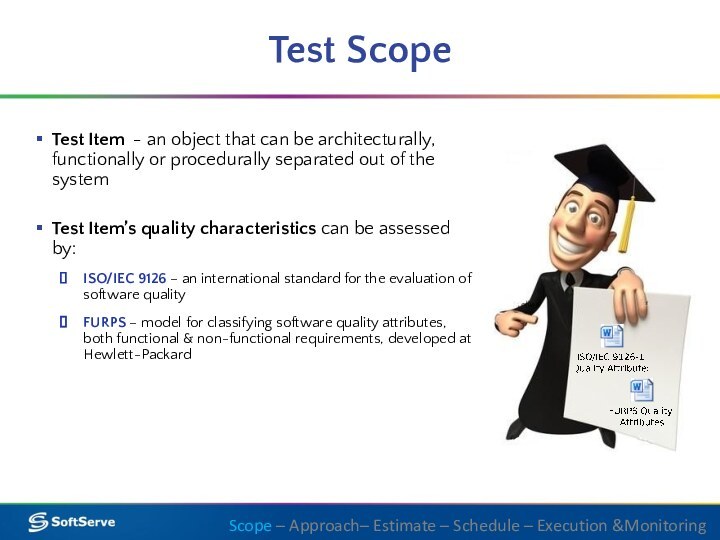
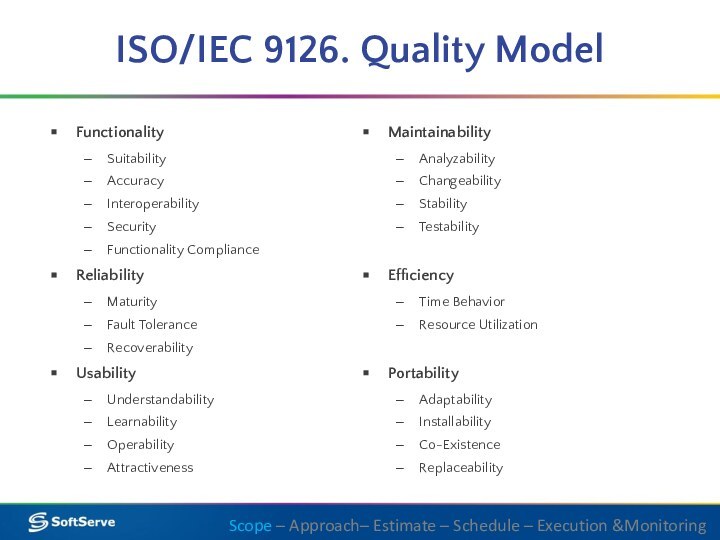
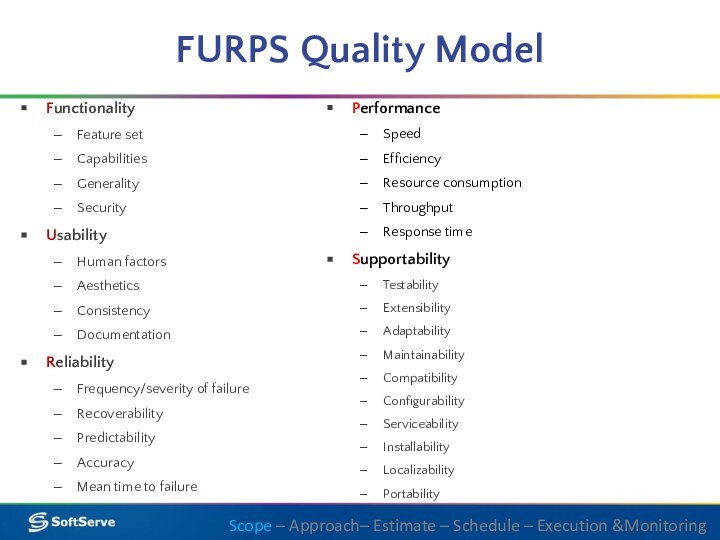
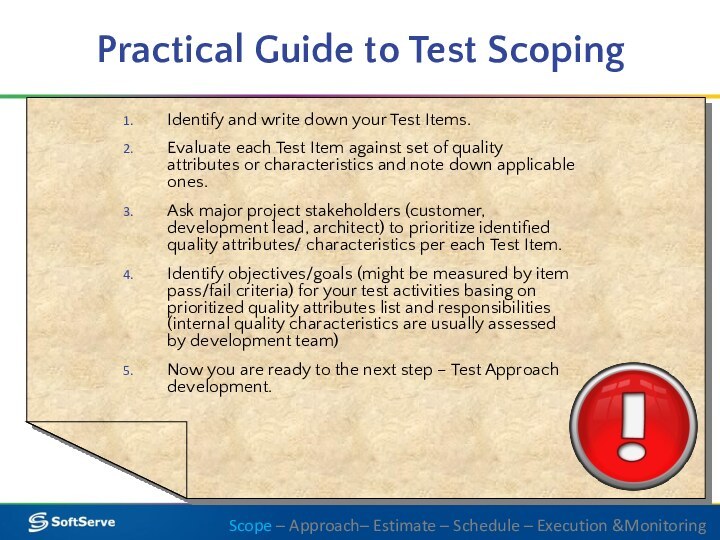

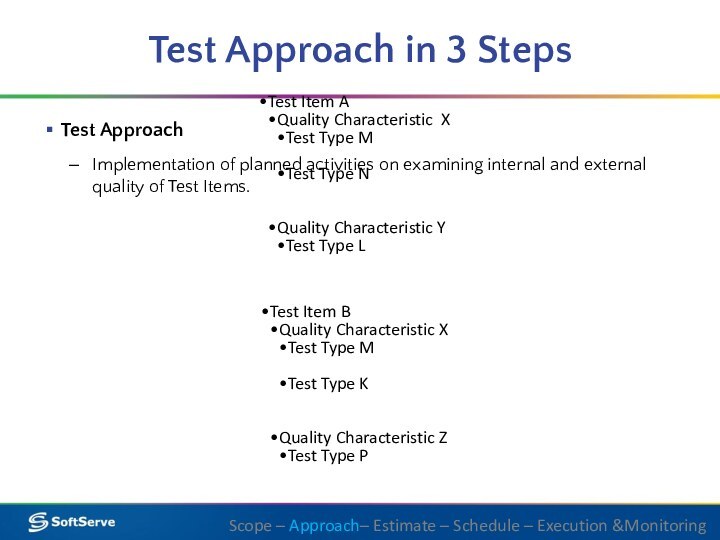




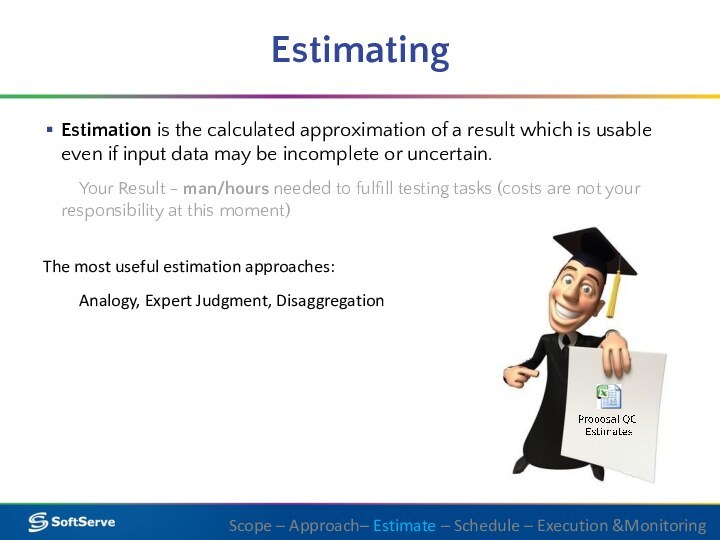
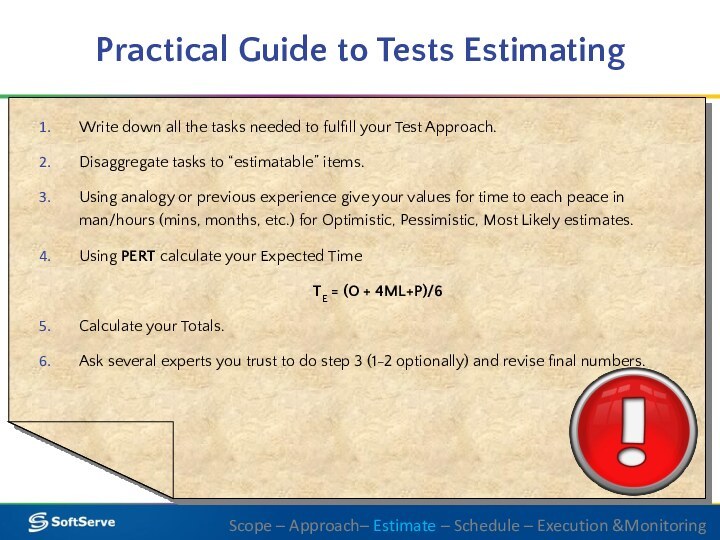
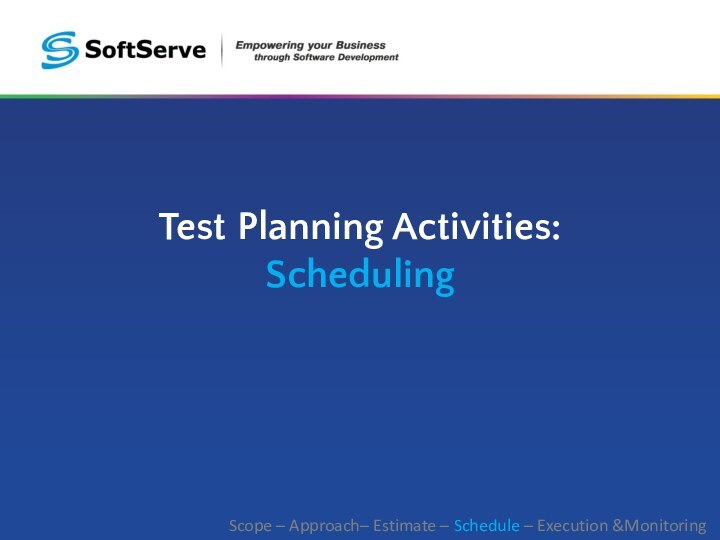
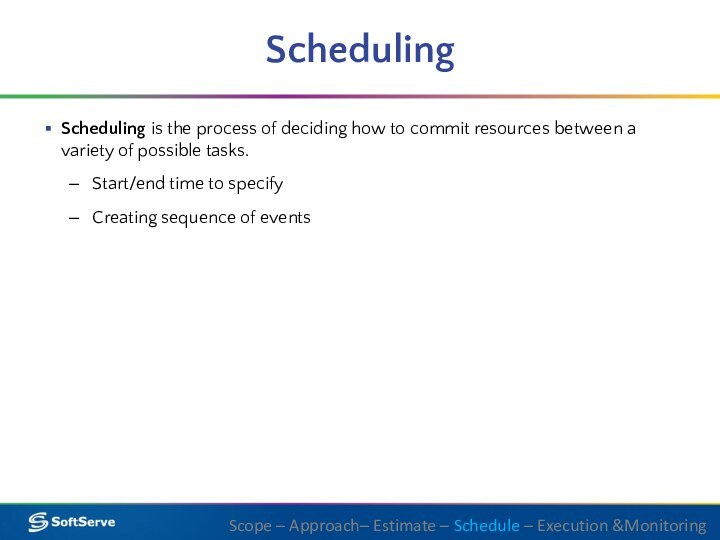




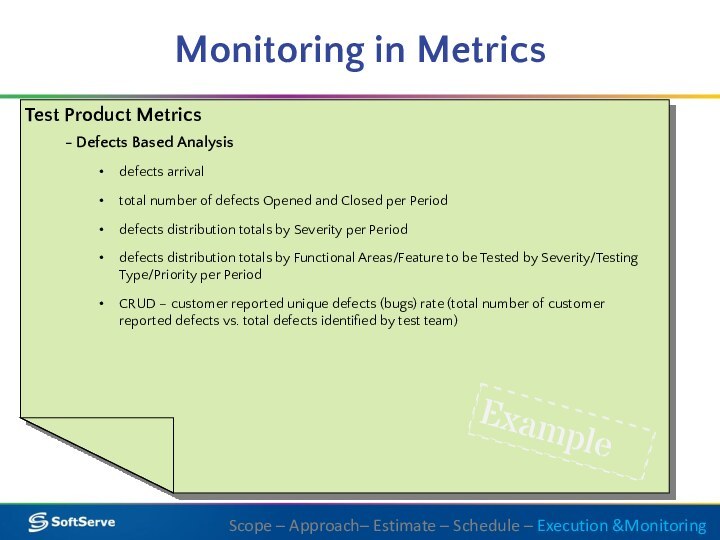


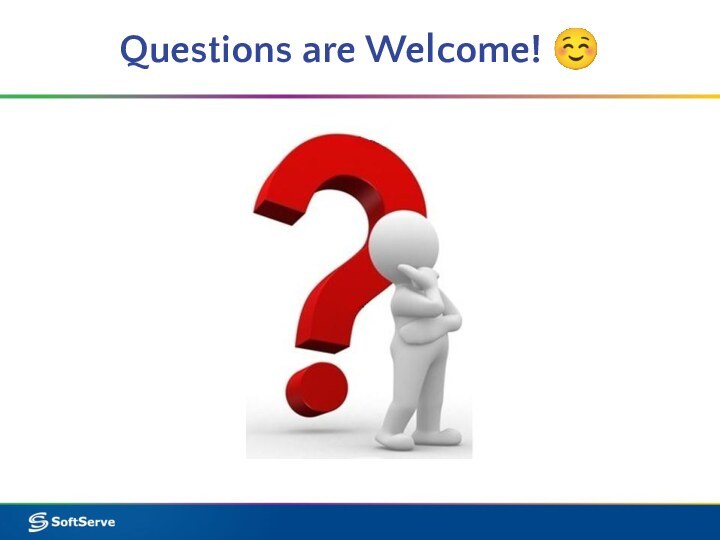

Слайд 2
Agenda
Part 1:
Introduction
SoftServe template
Overview of Major Sections. Examples
Part 2:
Test
Planning Activities:
Слайд 4
Introduction: Basic Terms
Testing
Test Plan
Test Planning
Introduction – SoftServe
Template – Major Sections Overview
engineering process of investigation conducted
to provide stakeholders with information about the quality of the product or service under test.activity aimed at determining test objectives and scope, approach, resources, environment, as well as estimates and schedule of project testing activities.
a document detailing a systematic approach to testing a system such as a machine or software. The main artifact of test planning.
Слайд 6
Test Planning: Myths
Myth #1
Test Plan is the set
of test cases
Myth #2
Both Test Planning as activity and
Test Plan do not exist in AgileIntroduction – SoftServe Template – Major Sections Overview
BUSTED
BUSTED
Слайд 7
Standards Regulating Test Plan
Institute of Electrical and Electronics
Engineers
IEEE 829. Standard for Test Documentation
US Department of Defense's
standard MIL-STD-498 (Military-Standard-498)
Introduction – SoftServe Template – Major Sections Overview
Слайд 8
Master Test Plan
1. Introduction
1.1. Document identifier
1.2. Scope
1.3. References
1.4.
System overview and key features
1.5. Test overview
2. Details of
the Master Test Plan2.1. Test processes including definition of test levels
2.2. Test documentation requirements
2.3. Test administration requirements
2.4. Test reporting requirements
3. General
3.1. Glossary
3.2. Document change procedures and history
Test Level Plan
1. Introduction
1.1. Document identifier
1.2. Scope
1.3. References
1.4. Level in the overall sequence
1.5. Test classes and overall test conditions
2. Details for this level of test plan
2.1 Test items and their identifiers
2.2 Test Traceability Matrix
2.3 Features to be tested
2.4 Features not to be tested
2.5 Approach
2.6 Item pass/fail criteria
2.7 Suspension criteria and resumption requirements
2.8 Test deliverables
3. Test management
3.1 Planned activities and tasks; test progression
3.2 Environment/infrastructure
3.3 Responsibilities and authority
3.4 Interfaces among the parties involved
3.5 Resources and their allocation
3.6 Training
3.7 Schedules, estimates, and costs
3.8 Risk(s) and contingency(s)
4. General
4.1 Quality assurance procedures
4.2 Metrics
4.3 Test coverage
4.4 Glossary
4.5 Document change procedures and history
Слайд 10
SoftServe Template
Test Plan
1 Introduction
1.1 Purpose
1.2 Overview
1.3 References
1.4 Definitions, Acronyms and Abbreviations
2
Test Items
2.1 Features To Be Tested
2.2 Features Not To Be Tested
3
Test Strategy 3.1 Test Approach
3.1.1 Test Focus
3.1.2 Test Coverage
3.1.3 Test Types
3.2 QA Efforts Workflow
3.3 Test Design
3.4 Test Execution
3.4.1 Test Status Reporting
3.4.2 Defect Tracking
3.5 Test Deliverables
3.6 Test Environment
3.6.1 Configurations
3.6.2 Testing Tools
3.7 Entrance Criteria
3.8 Pass/Fail Criteria
3.9 Exit Criteria
4 Roles and Responsibilities
5 Schedule
Agile Test Plan
1 Introduction
1.1 Purpose
1.2 Overview
1.3 References
1.4 Definitions, Acronyms and Abbreviations
2 Test Items
2.1 Features To Be Tested
2.2 Features Not To Be Tested
3 Test Strategy
3.1 Test Approach
3.1.1 Zero Sprint
3.1.2 Release Sprint
3.1.3 Test Focus
3.1.4 Test Coverage of Release
3.1.5 Test Types
3.2 QC Efforts Workflow
3.3 Test Design
3.4 Test Execution
3.4.1 Test Status Reporting
3.4.2 Defect Tracking
3.5 Test Deliverables
3.6 Test Environment
3.6.1 Configurations
3.6.2 Testing Tools
3.7 Entrance Criteria
3.8 Pass/Fail Criteria
3.9 Acceptance Criteria
Introduction – SoftServe Template – Major Sections Overview
Слайд 11
SoftServe Templates
Introduction – SoftServe Template – Major Sections
Overview
Based on IEEE 829
Слайд 14
Major Sections: Introduction
Identifier
Name which uniquely identifies the test
plan document
__.
Introduction
Purpose of the project
System under test overview
(both from technical and business standpoint)Project references properly versioned
Definitions, Acronyms and Abbreviations
Introduction – SoftServe Template – Major Sections Overview
Слайд 15
Major Sections: Introduction
1. Introduction
1.1 Purpose
The purpose of this
document is to work out in details the QC
activities required to be performed for SystemX project; to define the test strategy and approach to testing; to define the scope of the QC activities and to identify the responsibilities.1.2 Overview
SystemX is a product that allows users to organize and manage Business Cards, Receipts, Expense Reports, General Documents and generate Tax Information. Its primary purpose is to allow users to organize the paper clutter that has become a part of so many work environments. It is sold as a retail product to individuals and small businesses. The product is sold in both Brick and Mortar as well as Web based retail stores. The software is always sold in combination with a small portable scanner.
Introduction – SoftServe Template – Major Sections Overview
Example
Слайд 16
Major Sections: Test Items
Test Items
Test plan section describing
the test objects which are the subject of the
test planComponents that constitute the test object
Interfacing components required for test object testing
Procedures and instructions
Documents
Introduction – SoftServe Template – Major Sections Overview
Слайд 17
Test Items: Let’s Practice!
Test Items
The following components are
planned to be tested:
’s web-site
Interview Manager sub system
Users management
sub systemAccounts management sub system and logout
System under test highlights:
Client-server application with web interface that facilitates online interviews management and execution processes
Introduction – SoftServe Template – Major Sections Overview
Слайд 18
Major Sections: Features
Features to be Tested
List of features
which will be tested (defined for each of the
test items)Features Not to be Tested
List of features which will NOT be tested (defined for each of the test items)
Introduction – SoftServe Template – Major Sections Overview
Слайд 19
Major Sections: Quality Attributes
Introduction – SoftServe Template –
Major Sections Overview
Слайд 20
Features To Be Tested: Let’s Practice!
Features to Be
Tested
’s web-site
Home, Services, Customers, Resources, Our Company, Contact Us,
Careers, For Employers, For Candidates, For Recruiters, Partners, News & Events, Tour, Privacy.Interview Manager sub system
Interviews Manager home page
Managing calendar, recently recorded, pending interviews; Creating new interviews
Users management sub system
Adding/editing/viewing users (preferences)
Managing user roles
Searching for users
Accounts management sub system and logout
Adding/editing/deleting accounts
Signing in as another user
Searching for accounts; log out
System under test highlights:
Client-server application with web interface that facilitates online interviews management and execution processes.
Introduction – SoftServe Template – Major Sections Overview
Слайд 21
Major Sections: Strategy/ Approach
Test Strategy/Approach
The MOST important part
of a test plan, describing the implementation of testing
activities to meet quality expectation goalsIncludes the following:
Test levels, types, techniques and methods to be used
Sequence and description of testing activities
Distribution of resources
Test Strategy is an outline that describes the testing portion of the software development cycle
Test Approach describes the implementation of the test strategy for a specific project
Introduction – SoftServe Template – Major Sections Overview
Separate document usually
Part of a Test Plan
Слайд 22
Major Sections: Entry/Exit Criteria
Entry/Exit Criteria
Entry - conditions or
process that must be present before a process can
beginExit - conditions or process that must be present before a cycle completes
Introduction – SoftServe Template – Major Sections Overview
Слайд 23
Major Sections: Entry/Exit Criteria
Entry Criteria
Test Plan is reviewed
and approved by .
Test environments (staging, production sites) are
available.Test data is prepared.
Tools, defined in the “Tools” section of this document, are configured and available to QC Team. Access credentials are provided.
Exit Criteria
All testing tasks are completed.
Deliverables are prepared and placed on Portal.
Example
Introduction – SoftServe Template – Major Sections Overview
Слайд 24
Major Sections: Suspension & Resumption
Suspension Criteria and Resumption
Requirements
Section describes conditions that determine if a testing object
should be returned back to development team (testing stopped) and requirements for taking back test object for testing.Introduction – SoftServe Template – Major Sections Overview
Слайд 25
Major Sections: Suspension & Resumption
Suspension Criteria and
Resumption Requirements
Functional testing will be stopped in case:
Number
of Crash - Data Loss defects is constantly growing and reaches five items per single testing cycle.Following criteria must be met in order to proceed further with functional testing:
Crash - Data Loss defects are fixed and verified as passed
Automated tests are written for Crash-Data Loss defects and are included into Continuous build integration and verification procedures.
100% unit tests passed
100% smoke test passed
Example
Introduction – SoftServe Template – Major Sections Overview
Слайд 26
Major Sections: Pass/Fail Criteria
Item Pass/Fail Criteria
These are measurable
definitions of criteria clearly identifying that a test object
can be released from testingShould not be mixed up with System or User Acceptance criteria
Introduction – SoftServe Template – Major Sections Overview
Слайд 27
Major Sections: Pass/Fail Criteria
Item Pass/Fail Criteria
Functional testing is
not less than 98% passed on Test Environment with
no P1 and P2 functional defects remain non-addressed.Performance testing is 100% passed on Staging environment.
All Usability defects are addressed.
Example
Introduction – SoftServe Template – Major Sections Overview
Слайд 28
Major Sections: Deliverables
Test Deliverables
Section describing the work products
produced during test activities.
Should include the testing work product’s
attributes:name,
description,
format and version,
any standards work product should
correspond to.
Targets documents, tools and data, etc.
Introduction – SoftServe Template – Major Sections Overview
Слайд 29
Major Sections: Tasks and Environment
Testing Tasks
Set of tasks
necessary to prepare for and perform testing, accompanied with
entry/exit criteria and responsible personMay be tracked within management tool
Environmental Needs
Specifies both the necessary and the desired properties of the test environment and any relevant test data
Should include:
hardware and software
test support tools and databases
support personnel
security level
test level specifications requirements
Introduction – SoftServe Template – Major Sections Overview
Слайд 30
Major Sections: Staff & Responsibilities
Responsibilities
Mapping of project team
organizational roles to testing tasks
Staffing and Training Needs
Set
of required human resources’ skills mapped to testing tasksTest and domain-specific knowledge per each role
Trainings required and how they are going to be carried out
Introduction – SoftServe Template – Major Sections Overview
Слайд 31
Major Sections: Schedule
Schedule
Commonly this is a dynamic set
of milestones for testing team
Milestones are defined basing on
followinginformation:
test effort estimation
resources availability
project development lifecycle
risks and contingencies
Introduction – SoftServe Template – Major Sections Overview
Part 2
Слайд 32
Major Sections: Risks
Risks and Contingencies
List of possible events
that may prevent testing objectives/goals from being achieved; or
being achieved not in time.Includes information per each risk identified:
Rank
Probability x Impact
Response
Accept, Avoid, Mitigate, Transfer
Mitigation/Contingency Plan
Actions you take in case risk happens
Introduction – SoftServe Template – Major Sections Overview
Слайд 33
Risk-Based Testing
Risk-based testing
is a highly effective
testing strategy that can be used to find and
fix the most important problems as quickly as possible.(remember Pareto principle?)
How to use
Analyze the impact and probability of failure of the functionality or other quality characteristics being tested
Basing on analysis, adjust the tests and the extent of testing according to the risk priority levels
As new risk appears, re-plan
Introduction – SoftServe Template – Major Sections Overview
Слайд 34
Major Sections: Approvals
Approvals
List of project stakeholders with their
roles identified who need to sign off a test
plan as proof of notice.Should include, but not limited to:
Project manager – recognition of budget approval
Development leader – confirmation of test approach and involvement of dev. team resources
Customer representative – confirmation of proposed testing procedures
Test team – “act of commitment”
Introduction – SoftServe Template – Major Sections Overview
Слайд 38
Agenda
Part 1:
Introduction
SoftServe template
Overview of Major Sections. Examples
Part 2:
Test
Planning Activities:
Test Scoping
Test Approach development
Estimating
Scheduling
Execution and Monitoring
Scope – Approach–
Estimate – Schedule – Execution &Monitoring
Слайд 39
Test Planning Activities:
Test Scope
Scope – Approach– Estimate
– Schedule – Execution &Monitoring
Слайд 41
Introduction – SoftServe Template – Major Sections Overview
Test
Scope
=
Test Items
+
Test Items’ Quality Characteristics
Слайд 42
Test Scope
Test Item - an object that can
be architecturally, functionally or procedurally separated out of the
systemTest Item’s quality characteristics can be assessed by:
ISO/IEC 9126 – an international standard for the evaluation of software quality
FURPS – model for classifying software quality attributes, both functional & non-functional requirements, developed at Hewlett-Packard
Scope – Approach– Estimate – Schedule – Execution &Monitoring
Слайд 43
ISO/IEC 9126. Quality Model
Functionality
Suitability
Accuracy
Interoperability
Security
Functionality Compliance
Reliability
Maturity
Fault Tolerance
Recoverability
Usability
Understandability
Learnability
Operability
Attractiveness
Maintainability
Analyzability
Changeability
Stability
Testability
Efficiency
Time Behavior
Resource Utilization
Portability
Adaptability
Installability
Co-Existence
Replaceability
Scope
– Approach– Estimate – Schedule – Execution &Monitoring
Слайд 44
FURPS Quality Model
Functionality
Feature set
Capabilities
Generality
Security
Usability
Human factors
Aesthetics
Consistency
Documentation
Reliability
Frequency/severity of failure
Recoverability
Predictability
Accuracy
Mean time to failure
Performance
Speed
Efficiency
Resource consumption
Throughput
Response time
Supportability
Testability
Extensibility
Adaptability
Maintainability
Compatibility
Configurability
Serviceability
Installability
Localizability
Portability
Scope – Approach– Estimate
– Schedule – Execution &Monitoring
Слайд 45
Practical Guide to Test Scoping
Identify and write down
your Test Items.
Evaluate each Test Item against set of
quality attributes or characteristics and note down applicable ones.Ask major project stakeholders (customer, development lead, architect) to prioritize identified quality attributes/ characteristics per each Test Item.
Identify objectives/goals (might be measured by item pass/fail criteria) for your test activities basing on prioritized quality attributes list and responsibilities (internal quality characteristics are usually assessed by development team)
Now you are ready to the next step – Test Approach development.
Scope – Approach– Estimate – Schedule – Execution &Monitoring
Слайд 46
Test Planning Activities:
Test Approach
Scope – Approach– Estimate
– Schedule – Execution &Monitoring
Слайд 47
Test Approach in 3 Steps
Test Approach
Implementation of
planned activities on examining internal and external quality of
Test Items.Scope – Approach– Estimate – Schedule – Execution &Monitoring
Слайд 48
Practical Guide to Test Approach
Examination Method
Dynamic
Static
Testing
types to be applied
If testing type is applicable
for several Test Items, you need to specify any differences during execution. Execution method
Manual, Automated, Semi-Automated
Development and deployment process
New changes integration principle (regression testing and impact
analysis)
Environment Requirements
Scope – Approach– Estimate – Schedule – Execution &Monitoring
Слайд 49
Test Levels. Need to Know
While developing Test
Approach think at which test level you are going
to examine the system:Component
Integration
System
Acceptance (System Acceptance)
Scope – Approach– Estimate – Schedule – Execution &Monitoring
Слайд 50
Let’s Practice!
Identify test items
Select applicable quality characteristics
Propose
test approach
Scope – Approach– Estimate – Schedule – Execution
&Monitoring
Слайд 51
Test Planning Activities:
Estimating
Scope – Approach– Estimate –
Schedule – Execution &Monitoring
Слайд 52
Estimating
Estimation is the calculated approximation of a result
which is usable even if input data may be
incomplete or uncertain.Your Result - man/hours needed to fulfill testing tasks (costs are not your responsibility at this moment)
Scope – Approach– Estimate – Schedule – Execution &Monitoring
The most useful estimation approaches:
Analogy, Expert Judgment, Disaggregation
Слайд 53
Practical Guide to Tests Estimating
Write down all the
tasks needed to fulfill your Test Approach.
Disaggregate tasks to
“estimatable” items.Using analogy or previous experience give your values for time to each peace in man/hours (mins, months, etc.) for Optimistic, Pessimistic, Most Likely estimates.
Using PERT calculate your Expected Time
TE = (O + 4ML+P)/6
Calculate your Totals.
Ask several experts you trust to do step 3 (1-2 optionally) and revise final numbers.
Scope – Approach– Estimate – Schedule – Execution &Monitoring
Слайд 54
Test Planning Activities:
Scheduling
Scope – Approach– Estimate –
Schedule – Execution &Monitoring
Слайд 55
Scheduling
Scheduling is the process of deciding how
to commit resources between a variety of possible tasks.
Start/end
time to specify Creating sequence of events
Scope – Approach– Estimate – Schedule – Execution &Monitoring
Слайд 56
Practical Guide to Scheduling
As test scheduling always depends
on multi-factors analysis, consider the following:
Sequence driven order
Test infrastructure
set up firstPreparation activities second (requirements analysis, test data and tests design)
Execution activities third
Business driven order
Highest priority features first; milestones to meet
Resources availability driven order
Human resources
Tools and environment, time and cost
Development process driven order
New changes releasing and integration (regression testing, stabilization, code freeze slots to consider)
Scope – Approach– Estimate – Schedule – Execution &Monitoring
Слайд 57
Test Planning Activities:
Execution & Monitoring
Scope – Approach–
Estimate – Schedule – Execution &Monitoring
Слайд 58
Test Approach Execution
Test Execution - a step
by step implementation of selected approach to meet the
objectives set.Except of actual testing tasks execution following means of test planning to be considered:
Initiating Testing Tasks
Evaluating entry criteria
Monitoring (measurement and metrics) and Reporting
Product quality monitoring
Testing processes quality monitoring
Schedule monitoring
Reacting to Changes (re-planning)
Evaluating Test Completion
Have we tested enough?
Scope – Approach– Estimate – Schedule – Execution &Monitoring
Слайд 59
Monitoring in Metrics
Test Process Metrics
Test Design
number of Features
to be Tested covered by Tests vs. Total number
of Features to be Tested (test coverage)number of Tests Planned vs. Ready for Execution
total time spent on Preparation vs. Estimated time
Test Execution and Progress
number of Tests Executed vs. Tests Planned
number of Tests Passed, Failed and Blocked
total number of Tests Passed by Functional Areas/Feature to be Tested
total number of defects Verified Failed vs. total number of defects Closed
Total Time Spent on Execution vs. Estimated Time
Average response time to defect
Example
Scope – Approach– Estimate – Schedule – Execution &Monitoring
Слайд 60
Monitoring in Metrics
Test Product Metrics
- Defects Based
Analysis
defects arrival
total number of defects Opened and Closed
per Perioddefects distribution totals by Severity per Period
defects distribution totals by Functional Areas/Feature to be Tested by Severity/Testing Type/Priority per Period
CRUD – customer reported unique defects (bugs) rate (total number of customer reported defects vs. total defects identified by test team)
Example
Scope – Approach– Estimate – Schedule – Execution &Monitoring
Слайд 62
Reporting
Status reporting/Test Summary Report
Agreed Format
Document, e-mail, status call,
informal reporting
Timelines
Daily, weekly, monthly, per milestones
Typical scope
Accomplishments achieved since
last reportingPlanned goals to achieve till next reporting
Statistics (metrics on progress and product quality)
Issues
Test Summary Report -Document detailing results of testing, conclusions and recommendations made
Scope – Approach– Estimate – Schedule – Execution &Monitoring





